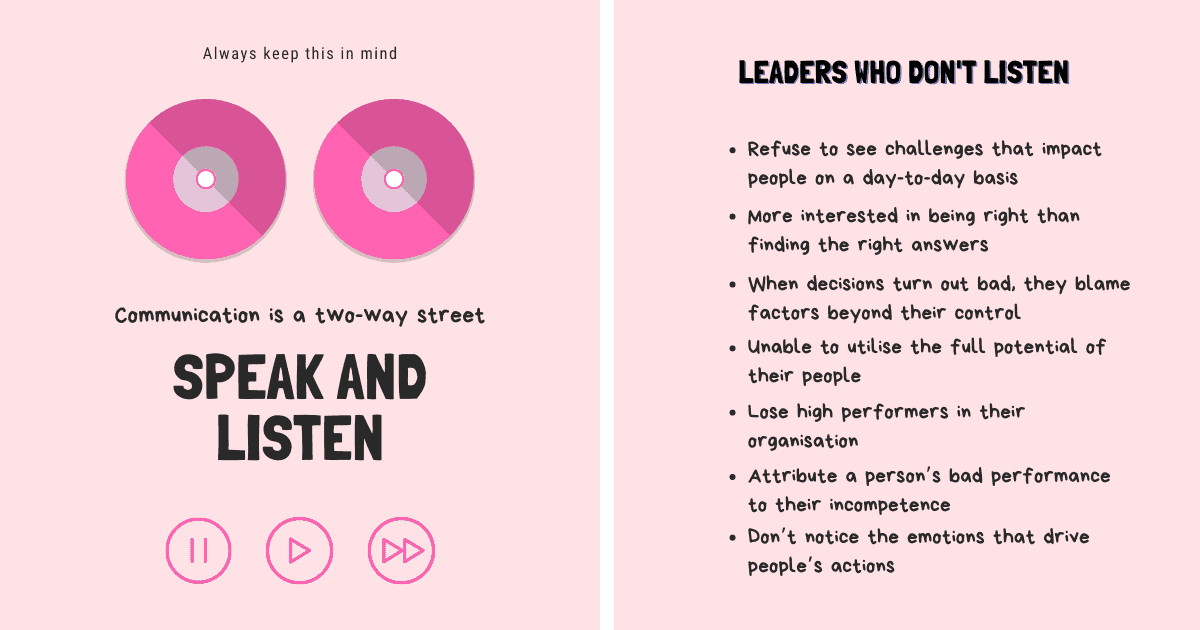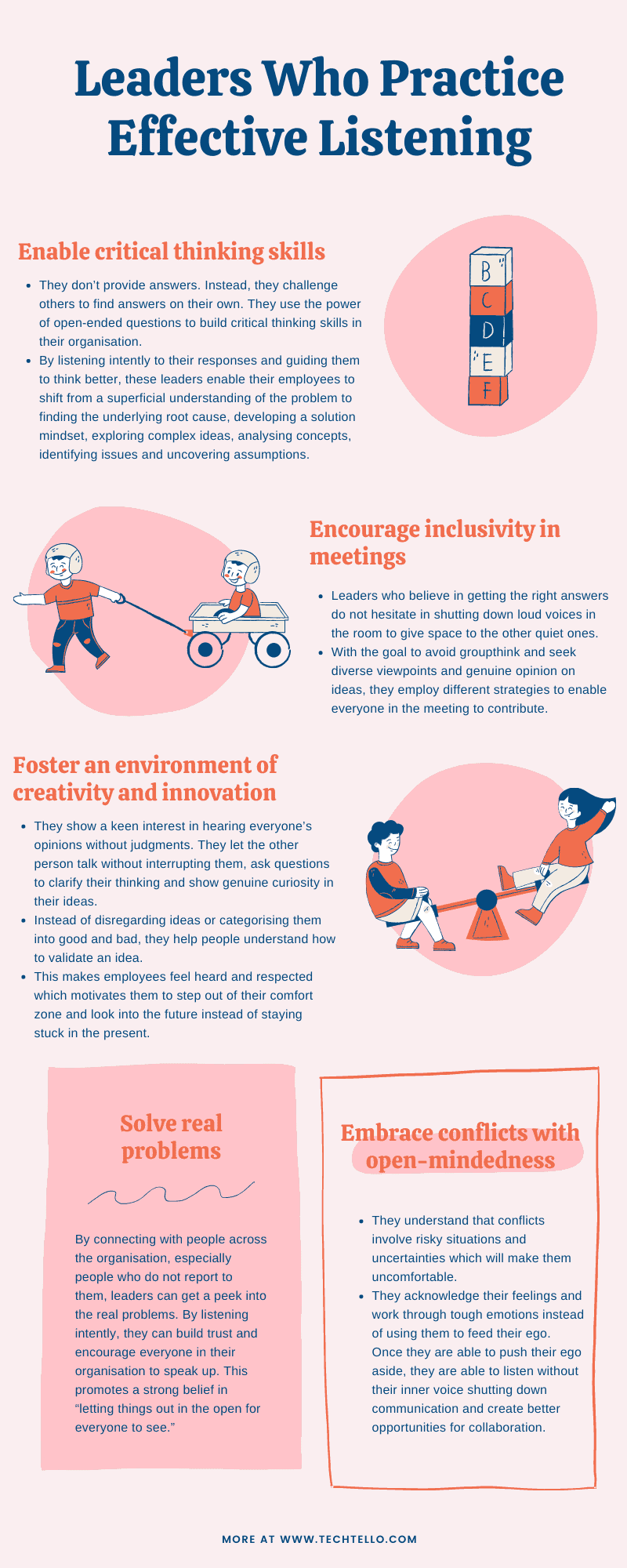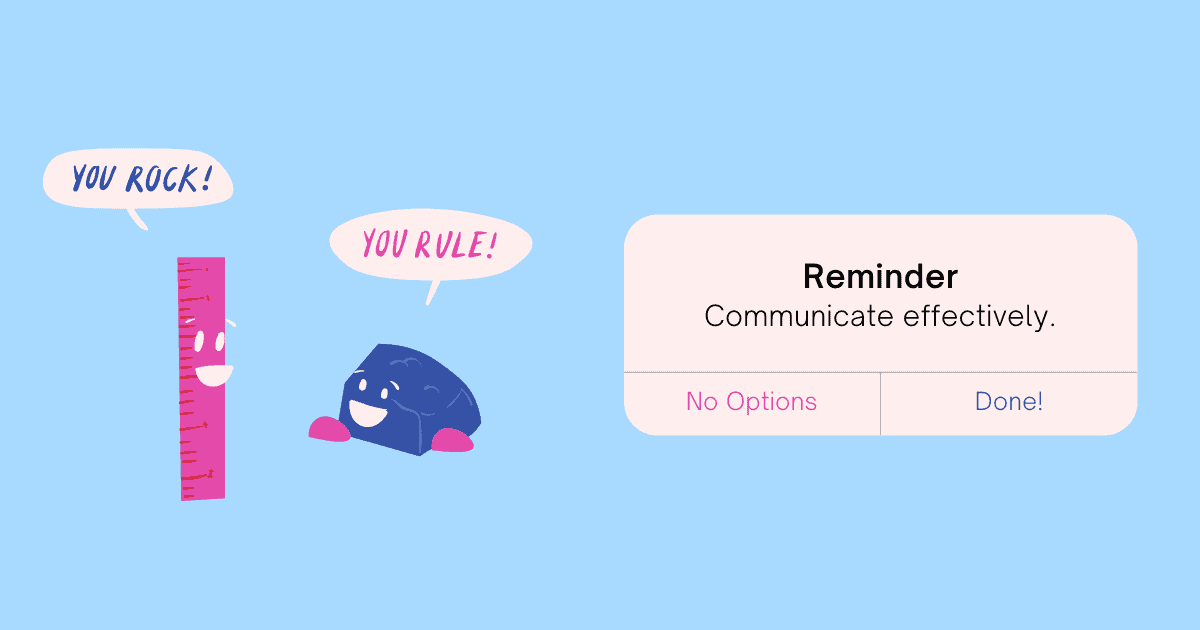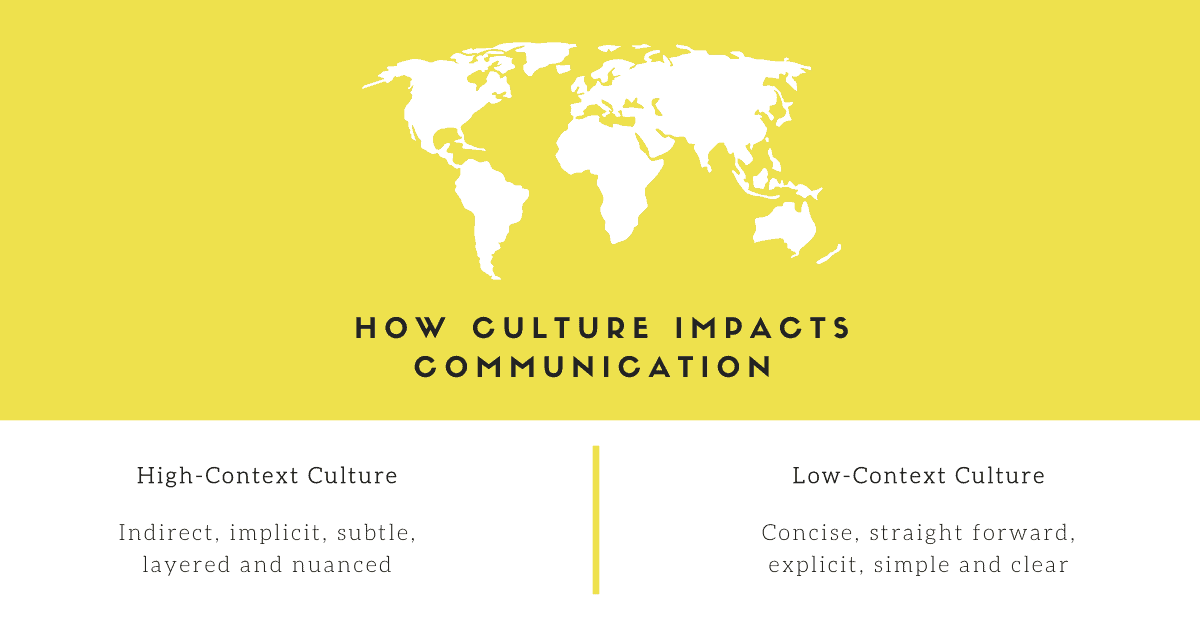How Effective Listening Can Make You A Better Leader

Think of a leader who constantly gives you advice, occasionally asks a question only to respond with their own opinion without giving you a chance to speak up your mind, interrupts you and doesn’t let you complete your thoughts, pretends to listen by nodding their head or making sounds like “aha..hmm…” when you can see that they are clearly distracted or those who don’t bother to ask a single question and leave you wondering what to make out of the one-sided conversation.
Don’t such leaders drive you crazy by pretending to be too busy to notice you and for making you feel that your ideas and opinions don’t count. Would you respect and trust them as a leader? Would you follow their advice out of a sense of authority or from a place of influence?
Without the ability to listen, these disillusioned leaders are disconnected from their people and their problems. They live with their own beliefs and assumptions and fail to see the reality that’s crippling their organisation.
Leaders who don’t practice effective listening fail to utilise the most important tool in their toolbox:
- They refuse to see the challenges that impact people on a day-to-day basis
- They are more interested in being right than finding the right answers
- When their decisions turn out bad, they blame factors beyond their control
- They are unable to utilise the full potential of their people
- They lose high performers in their organisation as they ignore signs of disengagement
- They attribute a person’s bad performance to their incompetence without taking other factors into account
- They don’t notice the emotions that drive people’s actions – are they acting out of anger and frustration or passion for their work.
These leaders fail to recognise that true value is created only when people listen to each other with the intent to add meaning to the conversation, when they are free to share an opinion without being judged and when they feel heard and respected for their views.
So true and relevant to the art of effective listening is the advice from Stephen R. Covey in The 7 Habits Of Highly Effective People, “Seek first to understand, then to be understood”. By following this as a single most effective principle, leaders can bring about a huge positive transformation in their organisations.
Leaders who practice effective listening
When leaders practice effective listening, they listen more than they talk, they not only bring their ears to the conversation but observe with their eyes as well, they commit to being mentally and physically present, they keep their judgments aside and make the other person feel comfortable by using positive body language and engage wholeheartedly in the conversation.
The positive effects of effective listening are seen not only when the leader is around, but also when they are long gone. These leaders create an army of thinkers who continue to add value to the organisation by putting their own effective listening skills to use.
Effective listening enables them to add value to the organisation by:
1. Enabling critical thinking skills
While leaders are expected to have all the answers and shelling out advice seems like a big part of their job, the mindset to preach and teach doesn’t help the people in the organisation.
If the employees don’t learn how to put their critical thinking skills to use and always rely on the leader to guide the next course of action, they miss opportunities to make corrections when the leader is wrong, they feel handicapped when the leader is not around and they definitely don’t enjoy the thrill that comes with implementing their own ideas.
The first few discussions with such leaders may seem exciting, but soon these conversations turn into a monologue and people start missing the adventure of a dialogue. They long for the roller coaster ride that comes with putting their critical thinking skills to use.
How to use effective listening to help others think better
When leaders practice effective listening, they don’t provide answers. Instead, they challenge others to find answers on their own. They use the power of open-ended questions to build critical thinking skills in their organisation:
- What’s your view on it
- How would you solve this
- Why do you think it didn’t work out
- What are the solutions you have tried to make it work
- What do you think is missing
- What resources have you gathered to try out your idea
“The point isn’t to be the hero and solve things; the point of the leader in a complex world is to enable and unleash as many heroes and as many solutions as possible”, says Jennifer Garvey Berger in Simple Habits for Complex Times.
By listening intently to their responses and guiding them to think better, these leaders enable their employees to shift from a superficial understanding of the problem to finding the underlying root cause, developing a solution mindset, exploring complex ideas, analysing concepts, identifying issues and uncovering assumptions. They challenge them to expand the boundary of their thinking to form new connections instead of sticking to what they know or what comes most intuitively to them.
2. Encouraging inclusivity in meetings
We are all drawn to extroverts who appear confident and are quick to express their viewpoint. Leaders who don’t listen well surround themselves with people who may be the loudest but may not have the best ideas.
By not paying attention to the quiet ones in the room, these leaders miss the opportunity to seek diverse viewpoints. This creates a ripple effect in the organisation where the loud ones continue to dominate with their ideas and the introverts stay away from speaking their mind.
Such leaders make bad decisions, do not recognise people with the best ideas and create an unspoken culture in which not speaking up is equated with incompetence. Without creating the necessary conditions for everyone to contribute, they do not utilise the knowledge and strength of a significant part of their workforce.
How to use effective listening to encourage inclusivity
Leaders who believe in getting the right answers do not hesitate in shutting down loud voices in the room to give space to the other quiet ones. They understand that each human being is different and what works for one may not work for the other.
With the goal to avoid groupthink and seek diverse viewpoints and genuine opinion on ideas, they employ different strategies to enable everyone in the meeting to contribute:
- They individually ask everyone in the meeting to share their viewpoint. When doing so, they embrace awkward silence and give enough time to the other person to put their thoughts together
- Instead of always relying on spontaneity, they set up upfront expectations for the meeting to enable everyone to be prepared with their views. It enables people who find it uncomfortable to share their opinion when put on the spot by practicing their ideas upfront
- They share their opinion in the end. This keeps the focus of the meeting on exchanging ideas instead of confirming to their line of thinking
- When working with people from different cultures, they understand how communication in high context and low context culture varies and take steps to reduce the communication gap
Through effective listening, they acknowledge their understanding and ask questions to clarify their doubts. This creates a positive environment in which people stick to the objective of the meeting and respect others by giving an opportunity for everyone to speak.
3. Fostering an environment of creativity and innovation
Leaders with a high sense of self-righteousness do not show curiosity to understand other people’s point of view. They shut down communication in their organisation by interrupting others, disregarding their opinion, expressing distrust in their ideas and even showing disgust when people disagree with their point of view.
Instead of asking how their behaviour discourages people from exploring creative ideas and building innovative solutions, they blame lack of creativity and innovation in their organisation on poor talent, incentive structures and other factors.
People stop participating in constructive criticism and healthy debates when they realise that their ideas will be rejected and disapproved before they are heard. You will often hear them saying “What’s the point in trying when no one is hearing anyways.”
How to use effective listening for creativity and innovation
When leaders engage in effective listening, they show a keen interest in hearing everyone’s opinions without judgments. They let the other person talk without interrupting them, ask questions to clarify their thinking and show genuine curiosity in their ideas.
Instead of disregarding ideas or categorising them into good and bad, they help people understand how to validate an idea:
- How is this idea relevant to the problem we are trying to solve
- What assumptions are you making
- What type of experiments can you perform to get more insights
- What data supports your hypothesis
- How does this idea connect with the future strategy of your team and organisation
- What do others say about its effectiveness
Instead of thinking about how to make an idea successful, they help people apply an inversion mental model to determine what factors can contribute to its failure. This form of reverse thinking is not intuitive, but extremely powerful to help them uncover their own blind spots.
“Failure isn’t a necessary evil. In fact, it isn’t evil at all. It is a necessary consequence of doing something new”, says Ed Catmull in Creativity, Inc.
This makes employees feel heard and respected which motivates them to step out of their comfort zone and look into the future instead of staying stuck in the present.
4. Solving real problems
When leaders stay distant from people who are involved in solving day-to-day problems and choose to engage with only their direct reports, they fail to see problems that impact people on a day-to-day basis.
By shutting their eyes and ears to a large part of their workforce, they listen selectively. They try to solve problems from a 10000 ft view where they can see only the tip of the iceberg and address the symptom instead of solving the root cause which is hidden below the surface.
They waste time in putting ineffective strategies into place and act clueless when it fails to produce the desired effect – improving engagement, increasing productivity, retaining high performers, designing incentive programs, producing high quality work, and reducing time spent in doing inconsequential activities.
How to use effective listening to uncover real problems
By connecting with people across the organisation, especially people who do not report to them, leaders can get a peek into the real problems. By listening intently, they can build trust and encourage everyone in their organisation to speak up. This promotes a strong belief in “letting things out in the open for everyone to see.”
Through effective listening, they not only focus on what the people in the organisation are saying, but also on how they are feeling. They use the power of skip-level meetings to find answers:
- Do they feel fearful or safe to take risks
- Are they empowered to make decisions or seek approval for every action
- Do they get the required support that helps them move forward or find themselves struggling every step of the way
- Do they feel recognised for their work or ignored without appreciation
- How do they feel being part of their team and this organisation
- Do they find the culture of the company conducive to learning or restrictive in growth
- How do they perceive fairness in the organisation
By watching out for non-verbal cues like emotions, tone of voice, reaction, and openness to share or reluctance to give information, they are able to cut through the noise and focus on the actual issues that require their attention.
5. Embracing conflicts with open-mindedness
When leaders relate conflict with negative emotions, they try to defend or diffuse the situation. By treating conflict as a thing to be avoided they shut doors to productive disagreements, become inflexible to change their mind and give in to confirmation bias by rejecting ideas that contradict their point of view.
This creates a culture in which people approach conflicts with a win-lose mentality. They either play safe and try to avoid it or fight it even when their arguments make no sense. They hide information, use manipulation and other dirty tricks to sway the person in their direction even when they know the other person is right.
The outcome of the conflict becomes a part of their identity – losing it signifies they are a loser while winning it makes them a champion.
How to use effective listening to manage conflicts productively
To apply effective listening skills while managing a conflict, leaders first accept vulnerability. They understand that conflicts involve risky situations and uncertainties which will make them uncomfortable. “The point is this: difficult conversations are almost never about getting the facts right. They are about conflicting perceptions, interpretations, and values”, says Douglas Stone in Difficult Conversations.
If they do not embrace the discomfort and risk the emotional exposure that comes with managing a conflict, they will not be able to listen effectively. They prepare for the conflict by asking:
- What’s my motive in this conversation
- How can I approach the other person with trust
- What language should I use to make sure I don’t attack the person and keep it about the specific situation
- What kind of questions can I ask to gain a better understanding of this conflict
- How can I build trust to enable the free flow of information
They acknowledge their feelings and work through tough emotions instead of using them to feed their ego. Once they are able to push their ego aside, they are able to listen without their inner voice shutting down communication and create better opportunities for collaboration.
How great leaders develop effective listening skills
Aristotle, the ancient Greek philosopher said “We are what we repeatedly do. Excellence, then, is not an act but a habit”.
Great leaders make effective listening a habit. Much like building any other skill, they use every opportunity to implement it, gather feedback and use their own analysis to find areas of improvement.
To put effective listening into practice, these leaders learn to:
- Step away from digital distractions by keeping their phones and laptops away
- Free up their mind from other work and personal distractions to be mentally and physically present and focus in the moment
- Create space for meaningful conversations by not running from one meeting to another
- Go beyond their words to other non-verbal cues like their tone of voice, emotions and reactions to interpret the message they are trying to convey
- Use open-ended questions instead of simple yes/no based questions to explore their point of view
- Encourage everyone to share their opinion
- Use self-awareness to notice when their mind wanders away to bring it back to the conversation
- Instead of passing judgment, they collaborate to refine ideas
- Do not interrupt when the other person is talking unless the person is speaking off-topic
- Embrace silence even if it’s uncomfortable at first to allow the other person to formulate their thoughts and speak their mind
Effective listening isn’t a choice for a leader. It’s the only way to lead people and drive excellence in an organisation.






























